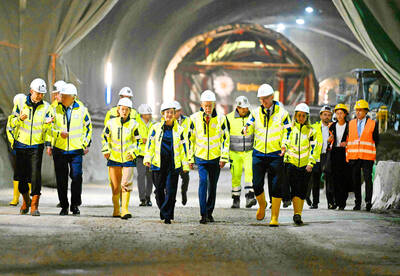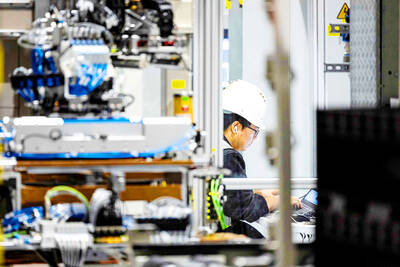Retail sales in the US probably stagnated last month because scant progress in the labor market made it difficult for Americans to boost spending, economists said before a report this week.
Purchases were unchanged last month after a 1.1 percent increase in February that was the biggest gain in five months, according to the median projection from 64 economists surveyed by Bloomberg before US Department of Commerce data is released on Friday.
A slowdown last month in hiring combined with little growth in wages may make it difficult for household spending, which account for about 70 percent of the economy, to extend gains seen at the end of last year and the first two months of this year. Nonetheless, Americans are finding relief in falling fuel prices and cheaper borrowing costs, which will prevent a slump.
‘WORRY’
“I worry a little bit about the economy going into the second quarter, but I don’t think all is weak,” said Raymond Stone, managing director of Stone & McCarthy Research Associates in Princeton, New Jersey, and the second-best forecaster of retail sales in the past two years, according to data compiled by Bloomberg.
“Automobiles, housing sales are doing better, lenders are beginning to ease standards, so I think there’s reason to believe that healing will continue,” Stone said.
Consumer spending probably grew at a 3.3 percent annualized rate from January through last month, marking its strongest performance in two years, according to a forecast by economists at JPMorgan Chase & Co in New York. Household purchases advanced at a 1.8 percent rate from October to December, figures from the Commerce Department show.
The pickup may not last, because purchases are projected to expand at a 1 percent pace this quarter, according to JPMorgan Chase.
Pickups in consumer and business spending probably helped the economy expand at a 4 percent annual rate in the first quarter, according to the JPMorgan Chase economists. They project growth will cool to a 1.5 percent pace this quarter.
Sales picked up in February even as higher taxes took more out of Americans’ pocketbooks. Congress agreed to a fiscal pact on Jan. 1 that gave a permanent tax break to 99 percent of citizens, while allowing the levy used to finance Social Security to revert to 6.2 percent from 4.2 percent. A worker earning US$50,000 a year is taking home about US$83 less a month because of the higher tax.
Fuel prices fell last month, a month when they typically rise, freeing up more cash for consumers to spend on other goods and services, and income tax returns have started to come in from the Internal Revenue Service.
COOLING
Still, signs of a cooling in the labor market may temper spending. Payrolls grew by 88,000 last month, the smallest gain since June. Employees’ average hourly earnings were unchanged last month from the prior month, the weakest showing since October, the US Department of Labor’s data released on Friday also showed.
“There’s a large group of consumers who are more financially constrained than they would like and can’t go out as often,” Darden Restaurants Inc chief operating officer Andrew Madsen said during an investor conference on Thursday.

CHIP RACE: Three years of overbroad export controls drove foreign competitors to pursue their own AI chips, and ‘cost US taxpayers billions of dollars,’ Nvidia said China has figured out the US strategy for allowing it to buy Nvidia Corp’s H200s and is rejecting the artificial intelligence (AI) chip in favor of domestically developed semiconductors, White House AI adviser David Sacks said, citing news reports. US President Donald Trump on Monday said that he would allow shipments of Nvidia’s H200 chips to China, part of an administration effort backed by Sacks to challenge Chinese tech champions such as Huawei Technologies Co (華為) by bringing US competition to their home market. On Friday, Sacks signaled that he was uncertain about whether that approach would work. “They’re rejecting our chips,” Sacks

It is challenging to build infrastructure in much of Europe. Constrained budgets and polarized politics tend to undermine long-term projects, forcing officials to react to emergencies rather than plan for the future. Not in Austria. Today, the country is to officially open its Koralmbahn tunnel, the 5.9 billion euro (US$6.9 billion) centerpiece of a groundbreaking new railway that will eventually run from Poland’s Baltic coast to the Adriatic Sea, transforming travel within Austria and positioning the Alpine nation at the forefront of logistics in Europe. “It is Austria’s biggest socio-economic experiment in over a century,” said Eric Kirschner, an economist at Graz-based Joanneum

BUBBLE? Only a handful of companies are seeing rapid revenue growth and higher valuations, and it is not enough to call the AI trend a transformation, an analyst said Artificial intelligence (AI) is entering a more challenging phase next year as companies move beyond experimentation and begin demanding clear financial returns from a technology that has delivered big gains to only a small group of early adopters, PricewaterhouseCoopers (PwC) Taiwan said yesterday. Most organizations have been able to justify AI investments through cost recovery or modest efficiency gains, but few have achieved meaningful revenue growth or long-term competitive advantage, the consultancy said in its 2026 AI Business Predictions report. This growing performance gap is forcing executives to reconsider how AI is deployed across their organizations, it said. “Many companies

France is developing domestic production of electric vehicle (EV) batteries with an eye on industrial independence, but Asian experts are proving key in launching operations. In the Verkor factory outside the northern city of Dunkirk, which was inaugurated on Thursday, foreign specialists, notably from South Korea and Malaysia, are training the local staff. Verkor is the third battery gigafactory to open in northern France in a region that has become known as “Battery Valley.” At the Automotive Energy Supply Corp (AESC) factory near the city of Douai, where production has been under way for several months, Chinese engineers and technicians supervise French recruits. “They